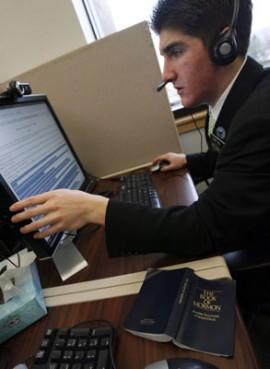
(RNS) Mormon missionary John Tagg of Spanish Fork, Utah, chats online with someone interested in learning more about the Church of Jesus Christ of Latter-day Saints. A group of Mormon missionaries answers questions at mormon.org through interactive chats, e-mails and on the phone. RNS file photo by Francisco Kjolseth/The Salt Lake Tribune.
SALT LAKE CITY (RNS) Not so long ago, Mormon missionaries were prohibited from using the Internet, even to contact their families. The system then loosened a bit to allow weekly e-mails home and some occasional viewing of church materials.
Now the nearly 14 million-member Church of Jesus Christ of Latter-day Saints is attempting to revolutionize the way Mormons find converts — and it's all online.
The move involves experimenting with blogging missionaries, self-produced member profiles and stereotype-busting videos. The American-born church, which has been harnessing technology to promote the faith since the 1920 radio days, sees great potential in fast-paced storytelling.
The Internet is the new “town square,” said Ron Wilson, manager of Internet and marketing for the church. “And Mormons are taking to it like never before.”
The electronic universe, however, also is uncontrollable, an aspect that has traditionally been tough for the hierarchical church but one that organizers readily acknowledge.
“We relinquish a lot of control to members on this site … and every one (of the authorities) is on board with it,” said Scott Swofford, director of media for the church's Missionary Department. “(The Internet) is where we've got to be.”
The online missionary effort began in 2001, with the launch of http://www.mormon.org, a site aimed at telling outsiders what Mormons believe. The church created it just before the world descended on Salt Lake City for the 2002 Winter Olympics, when people everywhere were asking about the church.
Two years ago, the church expanded the site to add a chat function and called its first online-only missionaries, who would discuss church doctrines with inquiring seekers from computer screens in cubicles at the Provo Missionary Training Center.
Then in May, LDS leaders asked a dozen full-time missionaries in Rochester, N.Y., to spend their mornings or downtime blogging, commenting on various sites that mention Mormonism and describing their experiences on Facebook.
The president of the Rochester mission is one of the “Facebook friends,” Wilson said, so he will know what missionaries write. Also, missionaries work in pairs and the church expects them to “police” each other — no inappropriate information shared and no accessing naughty sites, for example.
“It's a test,” Wilson said. “We'll learn if it's appropriate to give missionaries hand-held devices.”
To top it off, the church has rolled out additions to http://www.mormon.org, which currently showcases 15 video portraits and 2,000 written profiles of Mormons across the globe; there are another 75 videos and 13,000 more profiles ready to be posted.
The subjects, drawn from diverse occupations, ethnicities, ages and genders, were allowed wide license to share their lives and faith.
The site features testimonials from Joy Monahan, of Honolulu, who won the 2008 Longboard Surfing World Championship; professionals Aaron and Emily Sherinian in Arlington, Va., who describe their family's frenetic pace; Jeff Tucker, with a goatee, who talks about his love for sculpting motorcycles; and Valetin Marcero, who spent time in jail on drug charges before joining the church.
Each segment ends with the subject repeating his or her name, a detail about their lives and the words, “And I am a Mormon.”
The personal approach is the result of two findings from focus groups and public opinion surveys: Most Americans have either false or hostile impressions of the Utah-based church but typically change or soften those views after meeting a real-life member.
The idea, officials said, was to help everyone “know a Mormon.”
“Our leaders were struggling for years to find a more effective, less annoying way to get our message across than knocking on doors,” Swofford said. “Our mission is to deliver teaching opportunities.”
The online missionaries already have proven the program's success. They routinely participate in about 10,000 chats a week, with 3,500 people asking for in-person visits and 1,200 going on to hear the missionary lessons.
“It's a lot more effective than (door-to-door) tracting in many places,” Wilson said.
But what if the church authorities or its doctrinal office don't agree with how a missionary or member describes a particular doctrine? That's the only aspect that the site's monitors edit, and only in certain cases.
If a Mormon writes, “the church teaches that…,” the doctrinal statements have to be correct, Swofford said. Monitors will ask them to revise any wording that misrepresents the faith.
If the person writes, however, “I believe that …,” monitors leave it, he said. A person's belief is his or her own.
“There is no way you can read 10 profiles and think we are controlling what they are saying,” he said. “We want to show people how Mormons live their faith. We want them to be authentic and transparent. That is the way misperceptions disappear.”
(Peggy Fletcher Stack writes for The Salt Lake Tribune.)




